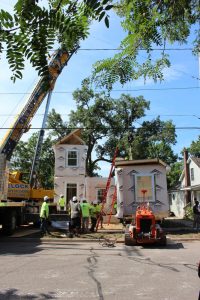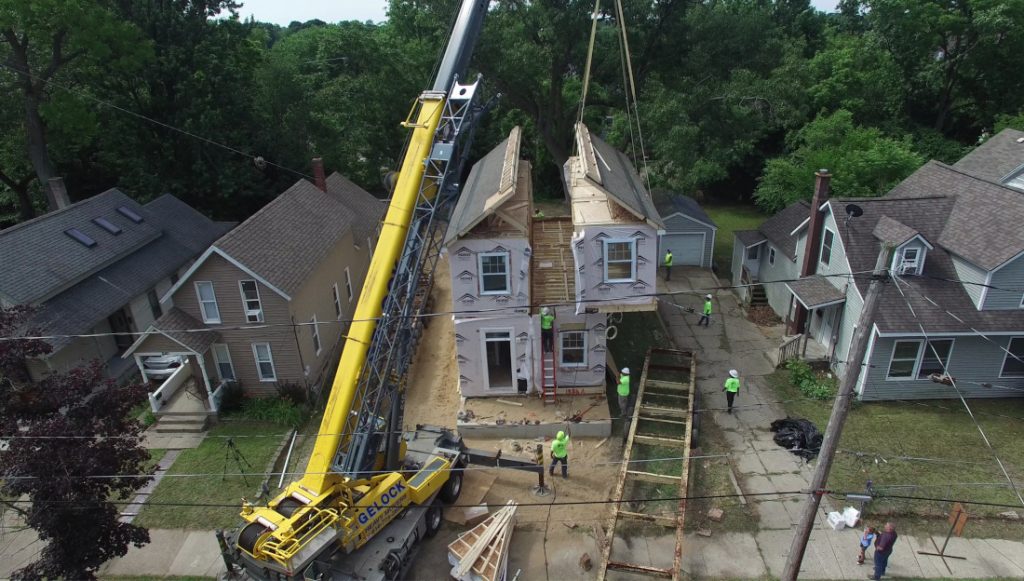Vacated City Parcels Get New Life, Potential Homebuyers Get Affordable Options
 A Michigan company that began as a pilot project with modular housing under the auspices of a county land bank contract is shaping up to be a national model for city infill and affordable housing for some of the country’s most difficult and expensive places to buy a home.
A Michigan company that began as a pilot project with modular housing under the auspices of a county land bank contract is shaping up to be a national model for city infill and affordable housing for some of the country’s most difficult and expensive places to buy a home.
“One of the largest housing challenges facing the United States is the lack of inventory,” said Todd Van Eck, a partner with David Allen in the newly incorporated business, called InnovaLab. “The lack of inventory in the urban setting has caused pricing to inflate at a rate that makes owning a home a real problem.”
The lack of inventory in urban communities and service-based communities is a crisis, Van Eck said. Families, in particular, cannot find affordable housing in the areas where jobs are most available.
“While the term ‘crisis’ is used to describe the housing inventory, the reality is that it negatively affects the very fiber of a community and the economy,” Van Eck said. “Quality housing, at an affordable price, is a must for every community.”
From County Pilot to Broad Incorporated Effort
MHInsider has followed the efforts of Kent County Land Bank — located in Grand Rapids, Mich., the county seat — and the rebranded InnovaLab entity in its efforts to provide a potential pilot program for an in-fill housing solution.
Since that time, Allen and his team have begun to phase out county contract work. It has set about the evolution of InnovaLab as a company to change the way housing is provided. And it uses off-site modular construction as one of its tools.
True to the root of its name — innovation — InnovaLab uses tools available to federal, state and local governments to generate affordable housing. It joins alternative methods of construction and efficient methods of operation to facilitate affordable housing at all income levels.
‘Breaking through traditional methods’
“InnovaLab is breaking through traditional methods of development to provide high-quality housing at an affordable price in communities throughout the country,” Allen said.
One of InnovaLab’s most important traits, as a company, is its ability to bring innovation to the development process. It does this with the use of tools available through various participants in order to get housing built.
Thinking beyond traditional residential development methods to work with the government, the nonprofit sector and private organizations has resulted in viable housing for in-fill. Among its most important partnerships in the new development process is InnovaLab’s relationship with Champion Home Builders. Champion makes a variety of factory-built housing, including modular.
InnovaLab cites numerous reasons why Champion Homes has been such a great partner. But, the predominant characteristic of Champion Homes is its team of people and processes, Van Eck said.
“Champion Homes has been outstanding in facilitating the design work of InnovaLab, providing its design expertise, putting those designs into modularized engineering,” he said. “Champion has been providing consistent high quality, and its ability to maintain a process that is simple and effective. Working with Champion Homes has allowed InnovaLab to provide an innovative cost-efficient mechanism that gets quality housing on in-fill properties.”

What Can Be Done with Off-Site Built Homes?
The reality of off-site construction is that most housing can be built using off-site methods. Off-site methods are used to construct single-family homes, multi-unit housing, apartment housing, and hotels. For InnovaLab, off-site modular construction is a key component of housing inventory, currently and in the future.
Steve Payne is the director of business development for U.S. operations with Champion Home Builders.
“There are some limitations with modular construction, but in many cases modular systems can work. We use the same materials, meet the same building codes, look the same and have many of the same amenities of traditional site-built construction,” Payne said. “Also, we are capable of meeting the neighborhood architectural characteristics in most infill settings.”
For InnovaLab, Champion Homes was selected as its provider of housing because of the ability to consistently maintain InnovaLab’s core requirements.
Those InnovaLab core requirements include:
- A defined process in design and construction
- Consistent quality
- Promotion of efficiencies
- Clear communication
- Maintenance of budgets and schedules
“The experience of actually going through the Champion Homes processes has exceeded expectations,” Allen said.

Why does InnovaLab see Off-Site Modular Homes as a key?
There are a number of reasons why InnovaLab uses off-site modular. The off-site modular construction process provides efficiency, consistent quality, defined timelines, and defined budgets. The Champion Homes process has permitted InnovaLab to generate designs that can be used on in-fill properties with great quality, desired layouts, and beautiful, modern interior design. The process also has provided InnovaLab with a clear pricing structure to permit an increase in amenities or a decrease in amenities with secure delivered pricing. It permits planning, budgeting, and execution of housing construction at a level unmatched by InnovaLab when using on-site methods.
In July 2018, InnovaLab had an entry-level modular home and a more high-end modular put on the city’s southeast side, as well as a mid-priced home on the northeast side of Grand Rapids.
All three homes came from Champion’s plant in Strattanville, Pa., and all arrived ready to set on their foundations within four weeks.
Each home came in at about 70 percent the cost of what its site-built counterpart would be, at about $105 per square foot. The median price per square foot in the U.S. is $148. In Grand Rapids, it’s about $129 — $142 per square foot in the metro area.
Eric DeLong, Grand Rapids’ interim city manager at the time, said he had some understanding of modular housing through his brother’s professional experience. It is impressive with how the product had taken great strides in quality, design, and aesthetics, he said.
“I felt that modular was a viable solution to the affordable housing problem here, and I’m pleased to see this pilot program going so well,” DeLong said. “InnovaLaB has launched a pilot with a lot of promise.”
More Modular Homes to Follow
The program continues its trajectory since the time those original three homes were installed last summer.
Another 10 modular residences have been installed, including a set of modular condos. And more orders are being taken.

Impressions of Modular Homes for City Infill
During a recent installation on the southeast side of the city, an agent for the home listings as well as nearby residents and business employees watched a crane lower pieces of two modular homes as work crews fixed them into place.
Tanya Powell-May is CEO of Legacy Homes GR, a Keller Williams agency.
“My team and I will list these three properties in a couple of months,” Powell-May said. “These are our first modular homes. We sold over 77 homes last year, but none were modular.
“I look at how quickly that home went up… that’s amazing,” she said. “We have a crisis here in terms of affordable housing. If we can get quality housing for people who need homes at this price point, that’s great. All over the nation, there’s a shortage in inventory, especially at this price point.”
Bobbie Locke, who works at a consulting agency across the street from the new homes, said it was “incredibly exciting” to see the new homes installed so efficiently.
“What a beautiful thing for the neighborhood,” she said. “The architecture is a perfect fit. Though the neighborhood is mature and established, they’ll fit right in. It’s a wonderful opportunity.
“It doesn’t just mean good housing, it means fast housing,” Locke said. “The fact they can do it so quickly means people who are waiting are going to get into homes faster.”
How Modular Homes Are Sold
Potential buyers can also treat these new modular homes as they would any other home for sale. When completed and priced, the homes are listed on the metro multiple listing service and will be open for offers. Allen said developers can make the math work for the land. So, the only obstacle is people’s general perception of off-site built homes.
Typically, that perception is changed with a walk-through of a modular home.
“The stigma associated with off-site modular homes is not well placed,” Van Eck said, noting how auto manufacturing has thrived with continued improved processes. “Like automobiles, it is time for housing to modernize its processes to focus on efficiency as well as quality.”
MHInsider Managing Editor Matt Milkovich contributed to this article.










